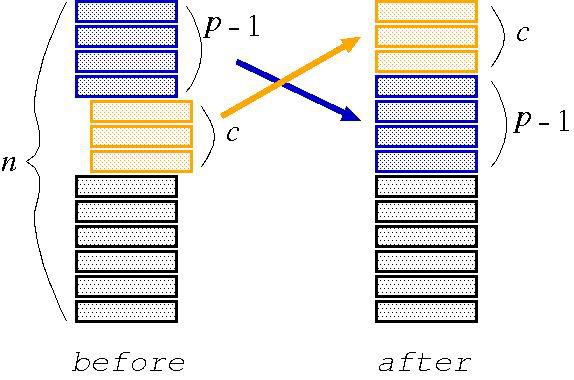最初给牌编号时,编号的顺序是从下到上;洗牌时,认牌的顺序是从上到下。注意使用循环是尽量统一“i”的初始化值,都为“0”或者都为“1”,限界条件统一使用“<”或者“<=”。
POJ - 1978 Hanafuda Shuffle
Time Limit: 1000MS Memory Limit: 30000KB 64bit IO Format: %I64d & %I64u
Description
There are a number of ways to shuffle a deck of cards. Hanafuda shuffling for Japanese card game 'Hanafuda' is one such example. The following is how to perform Hanafuda shuffling.
There is a deck of n cards. Starting from the p-th card from the top of the deck, c cards are pulled out and put on the top of the deck, as shown in Figure 1. This operation, called a cutting operation, is repeated.
Write a program that simulates Hanafuda shuffling and answers which card will be finally placed on the top of the deck.

Figure 1: Cutting operation
Input
The input consists of multiple data sets. Each data set starts with a line containing two positive integers n (1 <= n <= 50) and r (1 <= r <= 50); n and r are the number of cards in the deck and the number of cutting operations, respectively.
There are r more lines in the data set, each of which represents a cutting operation. These cutting operations are performed in the listed order. Each line contains two positive integers p and c (p + c <= n + 1). Starting from the p-th card from the top of the deck, c cards should be pulled out and put on the top.
The end of the input is indicated by a line which contains two zeros.
Each input line contains exactly two integers separated by a space character. There are no other characters in the line.
Output
For each data set in the input, your program should write the number of the top card after the shuffle. Assume that at the beginning the cards are numbered from 1 to n, from the bottom to the top. Each number should be written in a separate line without any superfluous characters such as leading or following spaces.
Sample Input
5 2
3 1
3 1
10 3
1 10
10 1
8 3
0 0
Sample Output
4
4
Source
1 #include<stdio.h> 2 #include<string.h> 3 #include<math.h> 4 #include<stdlib.h> 5 6 struct card{ 7 int i; 8 }; 9 10 card cards[60]; 11 card t[60]; 12 13 int main() 14 { 15 int n = 0, r = 0, p = 0, c = 0; 16 while(scanf("%d%d", &n, &r)) { 17 if(!n && !r) break; 18 for(int i = 1; i <= n; i++) { 19 cards[i].i = n-i+1; 20 } 21 for(int i = 1; i <= r; i++) { 22 scanf("%d%d", &p, &c); 23 for(int j = 1; j <= c; j++) { //抽牌 24 t[j] = cards[p+j-1]; 25 } 26 for(int j = p-1; j >= 1; j--) { //顶牌下落 27 cards[j+c] = cards[j]; 28 } 29 for(int j = 1; j <= c; j++) { //放顶牌 30 cards[j] = t[j]; 31 } 32 } 33 printf("%d ", cards[1].i); 34 } 35 36 return 0; 37 }